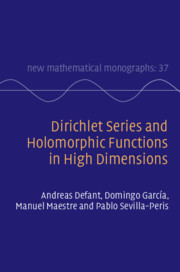Book contents
- Frontmatter
- Contents
- Introduction
- Part 1 Bohr’s Problem and Complex Analysis on Polydiscs
- 1 The Absolute Convergence Problem
- 2 Holomorphic Functions on Polydiscs
- 3 Bohr’s Vision
- 4 Solution to the Problem
- 5 The Fourier Analysis Point of View
- 6 Inequalities I
- 7 Probabilistic Tools I
- 8 Multidimensional Bohr Radii
- 9 Strips under the Microscope
- 10 Monomial Convergence of Holomorphic Functions
- 11 Hardy Spaces of Dirichlet Series
- 12 Bohr’s Problem in Hardy Spaces
- 13 Hardy Spaces and Holomorphy
- Part 2 Advanced Toolbox
- Part 3 Replacing Polydiscs by Other Balls
- Part 4 Vector-Valued Aspects
- References
- Symbol Index
- Subject Index
9 - Strips under the Microscope
from Part 1 - Bohr’s Problem and Complex Analysis on Polydiscs
Published online by Cambridge University Press: 19 July 2019
- Frontmatter
- Contents
- Introduction
- Part 1 Bohr’s Problem and Complex Analysis on Polydiscs
- 1 The Absolute Convergence Problem
- 2 Holomorphic Functions on Polydiscs
- 3 Bohr’s Vision
- 4 Solution to the Problem
- 5 The Fourier Analysis Point of View
- 6 Inequalities I
- 7 Probabilistic Tools I
- 8 Multidimensional Bohr Radii
- 9 Strips under the Microscope
- 10 Monomial Convergence of Holomorphic Functions
- 11 Hardy Spaces of Dirichlet Series
- 12 Bohr’s Problem in Hardy Spaces
- 13 Hardy Spaces and Holomorphy
- Part 2 Advanced Toolbox
- Part 3 Replacing Polydiscs by Other Balls
- Part 4 Vector-Valued Aspects
- References
- Symbol Index
- Subject Index
Summary
The solution of Bohr’s problem (see Chapter 4) implies that for every Dirichlet series in \mathcal{H}_\infty, the sum ∑ |a_n| n^(-s) is finite for every Re s > 1/2, and we ask if we can in fact get to Re s=1/2. This is addressed by considering, for Dirichlet polynomials, the quotient between ∑ | a_n | and the norm (in \mathcal{H}_\infty) of the polynomial. We define S(x) as the supremum over all Dirichlet polynomials of length x ≥ 2 of these quotients. It is shown that S(x)=exp(- (1/\sqrt{2} + o(1)) (log n loglog n)^(1/2)) as x goes to ∞. This is reformulated in terms of the Sidon constant of the monomials as characters of the infinite-dimensional polydisc. The proof uses the hypercontractive Bohnenblust-Hille inequality and a fine decomposition of the natural numbers as those having ‘big’ and ‘small’ prime factors. Also, a version for homegeneous Dirichlet series is given.
Keywords
Information
- Type
- Chapter
- Information
- Dirichlet Series and Holomorphic Functions in High Dimensions , pp. 205 - 229Publisher: Cambridge University PressPrint publication year: 2019
